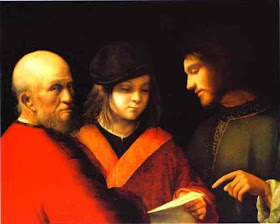The Pastoral Concert or Concert Champetre that now hangs in the Louvre is universally recognized as one of the world’s great masterpieces. Usually dated around 1510-1511 it is surrounded, like other famous paintings of the Venetian Renaissance, by an aura of mystery and enigma. Not only has scholarly opinion been divided about whether to attribute the painting to Giorgione or Titian, but also no one has been able to come up with a plausible explanation of the subject or meaning of the painting.
 |
| Titian: Pastoral Concert (Louvre) |
In this post I present a synopsis of a “working hypothesis” that provides a new interpretation of the subject of the Pastoral Concert and also resolves the question of attribution. I argue that Titian used the famous Biblical story of Jonathan and David to provide a framework for a personal homage to Giorgione, his recently deceased mentor and friend. The full 3500 word interpretation can be found at MyGiorgione, a site devoted to my work on Giorgione, Titian, and the art of the Venetian Renaissance.
Before going any further it should be noted that my reading is speculative and unorthodox. As far as I know a painterly homage would be unique and unprecedented in the art of the Venetian Renaissance. Nevertheless, there is no settled opinion on the subject of the Pastoral Concert, and a Titian homage to Giorgione answers most of the questions that have surrounded the painting. *
This interpretation explains why Titian put so many Giorgionesque elements in the painting, and also identifies the four main figures in the painting as well as their relationship with one another. The man on the left wearing finery and holding the lute is Giorgione. Many of the features of Giorgione that Vasari mentions in his short biography can be seen in this young man. Moreover, here-to-fore inexplicable details in the painting indicate that Giorgione is dead: his face is in shadow; the lute has no strings; and the nude on the left pouring into a well.
In addition, the dark sky in the background, a feature inappropriate for a pastoral idyll, was often used by artists as a sign of danger and death. Titian and others used it in crucifixion scenes, and artists often used it to depict the massacre of the Innocents in the background of depictions of the flight into Egypt.
In addition, the dark sky in the background, a feature inappropriate for a pastoral idyll, was often used by artists as a sign of danger and death. Titian and others used it in crucifixion scenes, and artists often used it to depict the massacre of the Innocents in the background of depictions of the flight into Egypt.
This interpretation then identifies the young rustic on the right as Titian. He depicts himself as Giorgione’s social inferior but also as his successor. His closeness to the other man as well as his connection with the flock in the mid ground brings to mind the biblical story of David and Jonathan. Titian identifies himself with David, the soul-mate and successor of Jonathan.
 |
| Cima da Conegliano: David and Jonathan National Gallery, London, c. 1506-10. |
My interpretation agrees with those scholars who have observed that the two female nudes in the painting are muses who are invisible to the two men. Although muses are the source of inspiration, the men are oblivious of their presence. Indeed, I argue that the two nudes are the same muse. She is Euterpe, the muse of lyric poetry and music. The standing nude is pouring Giorgione’s spirit out, but on the right she is looking directly at Titian.
To express his homage to the deceased Giorgione, Titian incorporated many Giorgionesque elements into the painting. Practically everything that Vasari said about Giorgione can be found in this painting. The most telling evidence is the reference to the story of the paragone where Giorgione claimed supremacy for painting over sculpture since he could portray every aspect of a figure on a flat surface. In one glance the viewer sees the front, the back and the profile of the nude Euterpe.
Many have seen that the relationship between the two young men in the Pastoral Concert is the key to the painting. Some have even seen a strong trace of “homo-eroticism.” In my opinion the bond between two young warriors, or two young artists is sufficient to explain the painting. Look at the painting and consider David’s lament on hearing the news of the death of Jonathan.
O Jonathan, in your death I am stricken###
I am desolate for you, Jonathan my brother.
Very dear to me you were,
Your love to me more wonderful
than the love of a woman. (2 Samuel 1:19-26)
* I originally wrote these words in May, 2013. This blog post is intended to present the interpretation to new readers and also provide some additional information. Only last year did I discover that art historian Christiane Joost-Gaugier had seen the painting as Titian's homage to the deceased Giorgione back in 1999. **
Initially, this discovery was somewhat embarrassing since I should have found Dr. Gaugier's interpretation earlier. However, it became somewhat comforting to find that I had come independently to a similar conclusion with someone of her stature, knowledge, and experience. Nevertheless, while I agree with much of Dr. Gaugier's analysis, I do have disagreements with some of the conclusions she drew from her insights.
I will discuss the areas of agreement and disagreement in a subsequent post.
** Joost-Gaugier, Christiane L. The mute poetry of the Fete Champetre: Titian’s memorial to Giorgione. Gazette des Beaux Arts, January 1999, Issue 1560, pp. 1-14.


